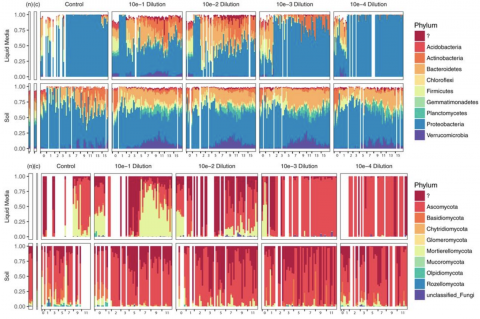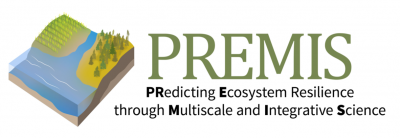Last updated on 2024-02-11T22:41:43+00:00 by LN Anderson Interferon Experiment IFNaIHH001 The purpose of this experiment was to evaluate the host interferon-stimulated cellular response to interferon alpha (IFNα) treatment. Sample data was obtained from human immortalized human hepatocyte cells (IHH...
Filter results
Category
- (-) Biology (258)
- (-) Visual Analytics (6)
- Scientific Discovery (369)
- Earth System Science (161)
- Human Health (112)
- Integrative Omics (73)
- Microbiome Science (47)
- National Security (31)
- Computational Research (25)
- Computing & Analytics (17)
- Chemical & Biological Signatures Science (12)
- Energy Resiliency (12)
- Weapons of Mass Effect (12)
- Chemistry (10)
- Data Analytics & Machine Learning (9)
- Computational Mathematics & Statistics (7)
- Materials Science (7)
- Atmospheric Science (6)
- Data Analytics & Machine Learning (6)
- Renewable Energy (6)
- Coastal Science (4)
- Ecosystem Science (4)
- Energy Storage (3)
- Plant Science (3)
- Solar Energy (3)
- Bioenergy Technologies (2)
- Cybersecurity (2)
- Distribution (2)
- Electric Grid Modernization (2)
- Energy Efficiency (2)
- Grid Cybersecurity (2)
- Transportation (2)
- Computational Mathematics & Statistics (1)
- Grid Analytics (1)
- High-Performance Computing (1)
- Subsurface Science (1)
- Terrestrial Aquatics (1)
- Wind Energy (1)
Tags
- Virology (77)
- Immune Response (51)
- Time Sampled Measurement Datasets (51)
- Differential Expression Analysis (46)
- Gene expression profile data (45)
- Homo sapiens (42)
- Predictive Phenomics (34)
- Mass spectrometry data (32)
- Multi-Omics (32)
- Viruses (27)
- Omics (25)
- Health (23)
- Mass Spectrometry (23)
- Soil Microbiology (23)
- Virus (23)
- MERS-CoV (19)
- Mus musculus (19)
- Proteomics (18)
- sequencing (13)
- West Nile virus (13)
- Genomics (12)
- High Throughput Sequencing (11)
- Influenza A (11)
- TA2 (11)
- Metagenomics (10)
- PerCon SFA (10)
- S. elongatus PCC 7942 (10)
- TA1 (10)
- Ebola (9)
- Microbiome (8)
Last updated on 2024-02-11T22:41:43+00:00 by LN Anderson Interferon Experiment IFNaCL001 The purpose of this experiment was to evaluate the host interferon-stimulated cellular response to interferon alpha (IFNα) treatment. Sample data was obtained from human lung adenocarcinoma cells (Calu-3)...
Category
Category
The data accompanies the manuscript that evaluates salinity-associated shifts in organic C thermodynamics, biochemical transformations, and heteroatom content in a first-order coastal watershed in the Olympic Peninsula of Washington state, USA. The files contain raw data including soil chemical...
Category
This study investigates how circadian clock regulation impacts carbon partitioning between storage, growth, and product synthesis in Synechococcus elongatus PCC 7942 in providing insights for potential strategies for enhanced bioproduction. In our analysis we explore circadian regulatory rewiring of...
Category
Coronaviruses (CoV) emerge suddenly from animal reservoirs to cause novel diseases in new hosts. Discovered in 2012, the Middle East respiratory syndrome coronavirus (MERS-CoV) is endemic in camels in the Middle East and is continually causing local outbreaks and epidemics. While all three newly...
Category
The ability of high-density lipoprotein (HDL) to promote cellular cholesterol efflux is a more robust predictor of cardiovascular disease protection than HDL-cholesterol levels in plasma. Previously, we found that lipidated HDL containing both apolipoprotein A-I (APOA1) and A-II (APOA2) promotes...
Category
Climate change is expected to increase the frequency of hotter and more intense droughts accompanied by aberrant precipitation events. Such extreme environmental shifts can trigger a complex cascade of microbial physiological responses that can impact the microbial community structure and functions...
Category
Please cite as: Graham E.B., and K.S. Hofmockel. 2021. "Ecological stoichiometry as a foundation for omics-enabled biogeochemical models of soil organic matter decomposition." Biogeochemistry 157. doi:10.1007/s10533-021-00851-2 Coupled biogeochemical cycles drive ecosystem ecology by influencing...
Category
Soil viruses are highly abundant and have important roles in the regulation of host dynamics and soil ecology. Climate change is resulting in unprecedented changes to soil ecosystems and the life forms that reside there, including viruses. In this Review, we explore our current understanding of soil...
Category
Metagenomics is unearthing the previously hidden world of soil viruses. Many soil viral sequences in metagenomes contain putative auxiliary metabolic genes (AMGs) that are not associated with viral replication. Here, we establish that AMGs on soil viruses actually produce functional, active proteins...
Category
Introduction: Understanding how microorganisms within a soil community interact to support collective respiration and growth remains challenging. Here, we used a model substrate, chitin, and a synthetic Model Soil Consortium (MSC-2) to investigate how individual members of a microbial community...
Category
ABSTRACT Fungal mineral weathering regulates the bioavailability of inorganic nutrients from mineral surfaces to organic matter and increase the bioavailable fraction of nutrients. Such weathering strategies are classified as biomechanical or biochemical. In the case of fungal uptake of mineral...
Category
ABSTRACT Climate change is causing an increase in drought in many soil ecosystems and a loss of soil organic carbon. Calcareous soils may partially mitigate these losses via carbon capture and storage. Here, we aimed to determine how irrigation-supplied soil moisture and perennial plants impact...
Category
The soil microbiome’s role in regulating biogeochemical processing is critical to the cycling and storage of soil organic carbon (C). The function of the microbiome under different land management uses has become a focal area of research due to the interest in managing soil C to mitigate climate...



